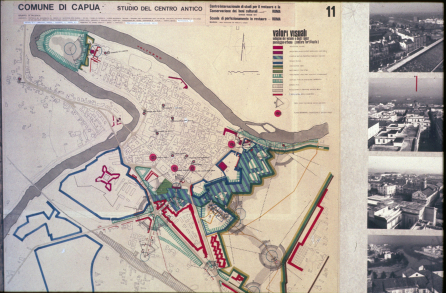Este dibujo, con fotografías integradas, representa el centro histórico de Capua, cerca de Nápoles, en 1971. Se explaya en los aspectos visuales, los volúmenes y las configuraciones espaciales del paisaje urbano dentro de la ciudad fortificada. El dibujo fue elaborado por los participantes de la edición del Curso de Conservación Arquitectónica de 1971, organizado por el ICCROM en cooperación con la Scuola di Perfezionamento in Restauro de la Universidad de Roma, La Sapienza.
El Curso Internacional de Conservación Arquitectónica (ARC según sus siglas en inglés) fue el primer programa de formación regular del ICCROM y se inició en el curso académico 1965-1966. Se creó en respuesta a las recomendaciones del II Congreso Internacional de Arquitectos y Técnicos de Monumentos Históricos celebrado en Venecia en mayo de 1964, en el que se aprobó la Carta de Venecia. El ICCROM desempeñó un papel clave en la redacción de la Carta.
Una resolución del Congreso relativa a la educación para la preservación y restauración de monumentos afirmaba: "[...] II. Que los cursos internacionales organizados en la Facultad de Arquitectura de la Universidad de Roma deben desarrollarse bajo un espíritu de cooperación internacional y de colaboración con el Centro Internacional de Estudios de Conservación y Restauración de Bienes Culturales. Que las autoridades nacionales interesadas deberán prestar su apoyo y facilitar la asistencia a estos cursos de jóvenes arquitectos, historiadores del arte y arqueólogos, que por su cualificación serán los que más puedan beneficiarse de ellos, de modo que se garantice un alto nivel científico. [...]".
Encarnando este espíritu, el curso ARC reunió en Roma a jóvenes profesionales de todo el mundo durante seis meses. Los participantes asistieron a conferencias de destacados expertos de distintos países y compartieron conocimientos y experiencias. El curso combinó teoría y práctica, a través de trabajos de campo que incluyeron el análisis práctico de edificios y zonas históricas de Italia, como Capua, Bolonia, Ferrara, Tívoli, y la propia Roma, así como de países vecinos, como Trogir (Croacia), Segovia (España) y Testour (Túnez).
Los proyectos de campo del ARC están documentados mediante planos arquitectónicos y fotogrametrías, material fotográfico e informes de estudio, disponibles en los Archivos del ICCROM. Como establece la Carta de Venecia en su Artículo 16:
"En todos los trabajos de conservación, restauración o excavación, debe existir siempre una documentación precisa en forma de informes analíticos y críticos, ilustrados con dibujos y fotografías. Deben incluirse todas las etapas de los trabajos de limpieza, consolidación, reordenación e integración, así como las características técnicas y formales identificadas en el transcurso de los trabajos. Este informe deberá conservarse en los archivos de una institución pública y ponerse a disposición de los investigadores. Se recomienda publicar el informe".
Nos complace confirmar que los participantes en el curso ARC siguieron estas recomendaciones y que sus trabajos de campo están bien documentados y conservados en el ICCROM, incluidas publicaciones relacionadas. En el caso de Capua: Brock, Ingrid; Giuliani, Paolo; Moisescu, Cristian. Il centro antico di Capua. Metodi d'analisi per la pianificazione architettonico-urbanistica. Marsilio, Padua, 1973.
Referencias
Carta de Venecia - 1964, ICOMOS. Charters and doctrinal texts - ICOMOS

